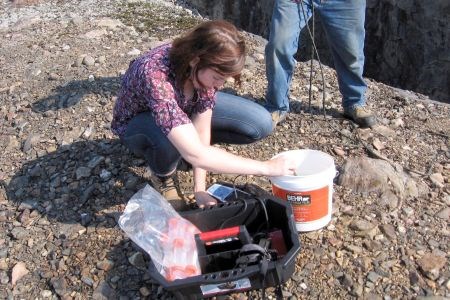For Ashley Scott of Sudbury's Laurentian University, old mines are untapped sources of green energy.
The professor and chemical engineer has the research to back up his ideas.
Scott explains working mines could start cleanup by using their own waste water as a source of green energy, but mines are slow to make change.
Change is perceived as risky.
In the town of Bruce Mines, 65 km east of Sault Ste. Marie, a committee of community leaders and chamber members are determined to discover if the old mines in their area can attract investment and create clean, green, above-ground jobs.
The town on the north shore of Lake Huron was the site of Canada's first copper mine in 1846. But the industry died out in the late 1940s leaving a warren of mine workings below ground.
Ramesh Mandal, a mineral development officer with the Ministry of Northern Development and Mines (MNDM), knows of cases where mine flood water was used for temperature control in working mines. He knows the theory works.
The same theory works with closed mines.
Scott recounts a few cases of closed mines in Yellowknife, NWT; Rhenish Massif, Germany; and Recsk, Hungary where energy studies were investigated.
In the Kongsberg mine in Norway – which was converted to a banquet and concert hall – they are planning to use a heat pump with a closed loop system to the flooded shaft to stabilize the temperatures.
Scott indicates the energy in abandoned mines coupled with a heat pump can heat or cool pools, spas, greenhouses, homes and factories, thaw roadways and anything else people can dream of. It’s green energy we ignore, he said.
Mandal is excited for the region. The theory could be used to reduce heating and cooling costs for any business.
There are several steps ahead and some additional levels of government involvement that the committee is investigating with MNDM and the Ministries of Labour (MOL) and Environment (MOE).
MOL will want reassurance that no one is to enter the abandoned mine and the MOE will want to know of potential contaminations. But with a closed loop system this would be minimal.
MNDM stores maps of the mines at the time of closure. Some are incomplete and this complicates the situation, but according to Mandal it is not a huge obstacle. In the worst case, an additional survey could be necessary with costs as much as $10,000.
Mandal and Scott agree there needs to be a study to determine the quality of the water in the mine. If the water is caustic, it could damage the pumps and piping required for any geothermal project, making the dream too expensive for today’s technology.
Committee member Peter Spik said the group is discussing developing a greenhouse near the intersection of Highways 638 and 17 at the eastern entrance to town as a visible demonstration project.
“We want to show the heating capacity of the mine site.”
Beth West, mayor of Plummer Additional Township, said a greenhouse fits with the agricultural base of the region.
Though Timmins conducted a similar study and has not proceeded with any kind of project, this is not discouraging the committee.
“There is no pot of gold out there yet,” said chamber member Brian Torrance. “We need to look for funding to proceed.”
Shawn Heard, general manager of the East Algoma Community Futures Development Corporation, doesn’t make any promises, but he said they did assist with the first study. “Everyone is curious about green energy. It seems like a nice fit.”
Howie Bowes, a Bruce Mines committee member, said the concept is sound.
“It could have a great future. For the cost of a small utility to extract the water we could get heat. It would eliminate any smokestack. It is very clean,” but he remains cautious since there is much work to be done.




